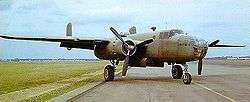Medium bomber



A medium bomber is a military bomber aircraft designed to operate with medium-sized bombloads over medium range distances; the name serves to distinguish this type from larger heavy bombers and smaller light bombers.
The term was used prior to and during World War II, based on available parameters of engine and aeronautical technology for bomber aircraft designs at that time. After the war, medium bombers were replaced in world air forces by more advanced and capable aircraft.
History
In the early 1930s many air forces were looking to modernize their existing bomber aircraft fleets, which frequently consisted of older biplanes. The new designs were typically twin-engined monoplanes, often of all-metal construction, and optimized for high enough performance and speed to help evade rapidly evolving fighter aircraft designs of the time. Some of these bombers, such as the Heinkel He 111, Junkers Ju 86, Savoia-Marchetti SM.79, Douglas B-18, and Armstrong Whitworth Whitley were developed from or in conjunction with existing airliners or transport aircraft.
The World War II-era medium bomber was generally considered to be any level bomber design that delivered about 4,000 pounds (1,800 kg) of ordnance over ranges of about 1,500 to 2,000 mi (2,400 to 3,200 km). Typical heavy bombers were those with a nominal load of 8,000 pounds (3,600 kg) or more, and light bombers carried up to 2,000 lb (907 kg).
These distinctions were beginning to disappear by the middle of World War II, when the average fighter aircraft could now carry a 2,000 lb (907 kg) bombload. Advances in powerplants and designs eventually allowed light bombers, tactical bombers, and later jet fighter-bombers to take over the roles performed by mediums.
After the war, use of the term generally vanished; some of this was due to mass demobilization of the participant air forces' existing equipment, and the fact that several of the most-produced medium bomber types were now technologically obsolescent. Although a number of later aircraft were designed in this performance and load-carrying range, they were henceforth referred to as tactical bombers or strike aircraft instead. Examples of post-war mediums include the English Electric Canberra (along with its derived U.S. counterpart, the Martin B-57) and the Soviet Ilyushin Il-28 "Beagle".
Subsequent to World War II, only the U.S. Strategic Air Command ever used the term "medium bomber" in the 1950s to distinguish its Boeing B-47 Stratojets from somewhat larger contemporary Boeing B-52 Stratofortress "heavy bombers" in bombardment wings (older B-29 and B-50 heavy bombers were also redesignated as "medium" during this period).[1][2][3] This nomenclature was purely semantic and bureaucratic, however as both the B-47 and B-52 strategic bombers were much larger and had far greater performance and load-carrying ability than any of the World War II-era heavy or medium bombers.
Notable Medium Bombers
- Introduced prior to World War II (September 1, 1939)
- Armstrong Whitworth Whitley — first of three British medium bombers
- Bloch MB.210
- CANT Z.1007
- Douglas B-18 Bolo — developed from the DC-2 airliner design
- Douglas B-23 Dragon
- Dornier Do 23
- Fiat BR.20 — first all-metal Italian bomber
- Handley Page Hampden — British medium bomber, almost as fast as the Bristol Blenheim
- Heinkel He 111 — considered a heavy bomber by the Luftwaffe for some missions
- Ilyushin DB-3 — precursor to the Il-4 (see below)
- Junkers Ju 86
- Lioré et Olivier LeO 45 — fast French medium bomber
- Martin B-10 — American bomber which was highly advanced at the time of its 1934 service introduction
- Mitsubishi G3M — known to the Allies as "Nell"
- Mitsubishi Ki-21 — "Sally"; replaced some Fiat BR.20 bombers in the Imperial Japanese Army Air Service
- PZL.37 Łoś
- Savoia-Marchetti SM.79 — three-engined Italian medium bomber used successfully as a torpedo bomber early in World War II
- Vickers Wellington — most-produced British medium bomber, with a unique aluminum lattice airframe designed by Barnes Wallis and capable of 2,500 miles range
- World War II
- de Havilland Mosquito — considered a multi-role aircraft
- Dornier Do 217 — considered a heavy bomber by the Luftwaffe for some missions
- Ilyushin Il-4 — long ranged Soviet bomber
- Junkers Ju 88 — versatile aircraft used in many different roles, including torpedo bomber, dive bomber, night fighter and reconnaissance
- Martin B-26 Marauder — had lowest mission loss rate of any USAAF bomber in World War II
- Mitsubishi G4M — known to the Allies as "Betty"
- Mitsubishi Ki-67 Hiryū — Allied reporting name "Peggy"; classified as heavy by the Imperial Japanese Army Air Service
- Nakajima Ki-49 Donryu — "Helen"
- North American B-25 Mitchell — most-produced American medium bomber
- Tupolev Tu-2 — used in multiple roles similar to the German Junkers Ju 88
- Yermolayev Yer-2
- Yokosuka P1Y Ginga — a medium bomber to the Imperial Japanese Navy Air Service; but in size, weight, speed etc. similar to Allied light bombers such as the Douglas A-26 Invader
- Post World War II
- Boeing B-47 - U.S. jet bomber
- Convair B-58 - U.S. supersonic bomber
- English Electric Canberra
- Ilyushin Il-28 — Soviet jet bomber
- Martin B-57 Canberra — U.S. development of the Canberra
- Douglas A-3 Skywarrior — U.S. naval jet strike aircraft; a derivative was adopted by USAF Tactical Air Command designated as the B-66 "tactical light bomber"
- North American A-5 Vigilante — U.S. naval supersonic jet strike aircraft
- Dassault Mirage IV — French supersonic jet strategic bomber
- Grumman A-6 Intruder — U.S. naval strike aircraft; approximate in size to a World War II medium with range and payload comparable to a World War II heavy bomber
- Blackburn Buccaneer — Royal Navy strike aircraft, similar and contemporary to the U.S. A-6 Intruder
- General Dynamics F-111 Aardvark — U.S. supersonic swing wing strike aircraft
See also
- Dive bomber
- High level bombing
- Maritime patrol aircraft
- Strategic bomber
- Tactical bombing
- Torpedo bomber